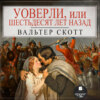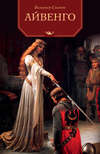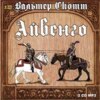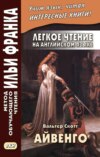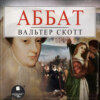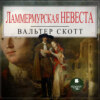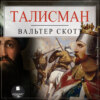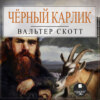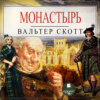Читать книгу: «Marmion», страница 10
‘Here Walter Scott has woo’d the northern muse;
Here he with me has joy’d to walk or cruise;
And hence has prick’d through Yten’s holt, where we
Have called to mind how under greenwood tree,
Pierced by the partner of his “woodland craft,”
King Rufus fell by Tyrrell’s random shaft.’
line 314. ‘The “History of Bevis of Hampton” is abridged by my friend Mr. George Ellis, with that liveliness which extracts amusement even out of the most rude and unpromising of our old tales of chivalry. Ascapart, a most important personage in the romance, is thus described in an extract: -
“This geaunt was mighty and strong,
And full thirty foot was long.
He was bristled like a sow;
A foot he had between each brow;
His lips were great, and hung aside;
His eyen were hollow, his mouth was wide;
Lothly he was to look on than,
And liker a devil than a man.
His staff was a young oak,
Hard and heavy was his stroke.”
Specimens of Metrical Romances, vol. ii. p. 136.
‘I am happy to say, that the memory of Sir Bevis is still fragrant in his town of Southampton; the gate of which is sentinelled by the effigies of that doughty knight errant and his gigantic associate.’-SCOTT.
CANTO FIRST
The Introduction is written on a basis of regular four-beat couplets, each line being technically an iambic tetrameter; lines 96, 205, and 283 are Alexandrines, or iambic hexameters, each serving to give emphasis and resonance (like the ninth of the Spenserian stanza) to the passage which it closes. Intensity of expression is given by the triplet which closes the passage ending with line 125. The metrical basis of the movement in the Canto is likewise iambic tetrameter, but the trimeter or three-beat line is freely introduced, and the poet allows himself great scope in his arrangement.
Stanza I. line 1. ‘The ruinous castle of Norham (anciently called Ubbanford) is situated on the southern bank of the Tweed, about six miles above Berwick, and where that river is still the boundary between England and Scotland. The extent of its ruins, as well as its historical importance, shows it to have been a place of magnificence, as well as strength. Edward I resided there when he was created umpire of the dispute concerning the Scottish succession. It was repeatedly taken and retaken during the wars between England and Scotland; and, indeed, scarce any happened, in which it had not a principal share. Norham Castle is situated on a steep bank, which overhangs the river. The repeated sieges which the castle had sustained, rendered frequent repairs necessary. In 1164, it was almost rebuilt by Hugh Pudsey, Bishop of Durham, who added a huge keep, or donjon; notwithstanding which, King Henry II, in 1174, took the castle from the bishop, and committed the keeping of it to William de Neville. After this period it seems to have been chiefly garrisoned by the King, and considered as a royal fortress. The Greys of Chillinghame Castle were frequently the castellans, or captains of the garrison: Yet, as the castle was situated in the patrimony of St. Cuthbert, the property was in the see of Durham till the Reformation. After that period, it passed through various hands. At the union of the crowns, it was in the possession of Sir Robert Carey, (afterwards Earl of Monmouth,) for his own life, and that of two of his sons. After King James’s accession, Carey sold Norham Castle to George Home, Earl of Dunbar, for L6000. See his curious Memoirs, published by Mr. Constable of Edinburgh.
‘According to Mr. Pinkerton, there is, in the British Museum. Cal. B. 6. 216, a curious memoir of the Dacres on the state of Norham Castle in 1522, not long after the battle of Flodden. The inner ward, or keep, is represented as impregnable: – “The provisions are three great vats of salt eels, forty-four kine, three hogsheads of salted salmon, forty quarters of grain, besides many cows and four hundred sheep, lying under the castle-wall nightly; but a number of the arrows wanted feathers, and a good Fletcher [i.e. maker of arrows] was required.”-History of Scotland, vol. ii. p. 201, note.
‘The ruins of the castle are at present considerable, as well as picturesque. They consist of a large shattered tower, with many vaults, and fragments of other edifices, enclosed within an outward wall of great circuit.’-SCOTT.
line 4. battled = embattled, furnished with battlements. See Introd. to Canto V. line 90, and cp. Tennyson’s ‘Dream of Fair Women,’ line 220: -
‘The valleys of grape-loaded vines that glow
Beneath the battled tower.’
the donjon keep. ‘It is perhaps unnecessary to remind my readers, that the donjon, in its proper signification, means the strongest part of a feudal castle; a high square tower, with walls of tremendous thickness, situated in the centre of the other buildings, from which, however, it was usually detached. Here, in case of the outward defences being gained, the garrison retreated to make their last stand. The donjon contained the great hall, and principal rooms of state for solemn occasions, and also the prison of the fortress; from which last circumstance we derive the modern and restricted use of the word dungeon. Ducange (voce DUNJO) conjectures plausibly, that the name is derived from these keeps being usually built upon a hill, which in Celtic is called DUN. Borlase supposes the word came from the darkness of the apartments in these towers, which were thence figuratively called Dungeons; thus deriving the ancient word from the modern application of it.’-SCOTT.
line 6. flanking walls, walls protecting it on the sides. Cp. the use of flanked in Dryden’s ‘Annus Mirabilis’ xxvi; -
‘By the rich scent we found our perfumed prey,
Which, flanked with rocks, did close in covert lie.’
Stanza II. line 14. St. George’s banner. St. George’s red cross on a white field was the emblem on the English national standard. Saint George is the legendary patron saint who slew the dragon.
Stanza III. line 29. Horncliff-hill is one of the numerous hillocks to the east of Norham. There is a village of the same name.
A plump of spears. Scott writes, ‘This word applies to flight of water-fowl; but is applied by analogy to a body of horse: -
“There is a knig ht of the North Country,
Which leads a lusty plump of spears.”
Flodden Field
line 33. mettled, same as metalled (mettle being a variant of metall, spirited, ardent. So ‘mettled hound’ in ‘Jock o’ Hazeldean.’ Cp. Julius Caesar, iv. 2. 23: -
‘But hollow men, like horses hot at hand,
Make gallant show and promise of their mettle.’
‘Metal’ in the same sense is frequent in Shakespeare. See Meas. for Meas. i. I; Julius Caesar, i. 2; Hamlet, iii 2.
line 35. palisade (Fr. paliser, to enclose with pales), a firm row of stakes presenting a sharp point to an advancing party.
line 38. hasted, Elizabethanism = hastened. Cp. Merch. of Venice, ii. 2. 104-‘Let it be so hasted that supper be ready at the farthest by five of the clock.’
line 42. sewer, taster; squire, knight’s attendant; seneschal, steward. See ‘Lay of the Last Minstrel,’ vi. 6, and note on Par. Lost, ix. 38, in Clarendon Press Milton: -
‘Then marshalled feast
Served up in hall with sewers, and seneschals.’
Stanza IV. line 43. Malvoisie = Malmsey, from Malvasia, now Napoli di Malvasia, in the Morea.
line 55. portcullis, a strong timber framework within the gateway of a castle, let down in grooves and having iron spikes at the bottom.
Stanzas V and VI. Marmion, strenuous in arms and prudent in counsel, has a kinship in spirit and achievement with the Homeric heroes. Compare him also with the typical knight in Chaucer’s Prologue and the Red Cross Knight at the opening of the ‘Faerie Queene.’ Scott annotates ‘Milan steel’ and the legend thus: -
‘The artists of Milan were famous in the middle ages for their skill in armoury, as appears from the following passage, in which Froissart gives an account of the preparations made by Henry, Earl of Hereford, afterwards Henry IV, and Thomas, Duke of Norfolk, Earl Marischal, for their proposed combat in the lists at Coventry: – ”These two lords made ample provisions of all things necessary for the combat; and the Earl of Derby sent off messengers to Lombardy, to have armour from Sir Galeas, Duke of Milan. The Duke complied with joy, and gave the knight, called Sir Francis, who had brought the message, the choice of all his armour for the Earl of Derby. When he had selected what he wished for in plated and mail armour, the Lord of Milan, out of his abundant love for the Earl, ordered four of the best armourers in Milan to accompany the knight to England, that the Earl of Derby might be more completely armed.”-JOHNES’ Froissart, vol. iv. p.597.
‘The crest and motto of Marmion are borrowed from the following story: -
Sir David de Lindsay, first Earl of Cranford, was, among other gentlemen of quality, attended, during a visit to London in 1390, by Sir William Dalzell, who was, according to my authority, Bower, not only excelling in wisdom, but also of a lively wit. Chancing to be at the Court, he there saw Sir Piers Conrtenay, an English knight, famous for skill in tilting, and for the beauty of his person, parading the palace, arrayed in a new mantle, bearing for device an embroidered falcon, with this rhyme, -
“I bear a falcon, fairest of night,
Whoso pinches at her, his death is dight1
In graith2.”
–
1prepared. 2armour.
–
‘The Scottish knight, being a wag, appeared next day in a dress exactly similar to that of Courtenay, but bearing a magpie instead of the falcon, with a motto ingeniously contrived to rhyme to the vaunting inscription of Sir Piers: -
“I bear a pie picking at a piece,
Whoso picks at her, I shall pick at his nese3,
In faith.”
–
3nose
–
‘This affront could only be expiated by a just with sharp lances. In the course, Dalzell left his helmet unlaced, so that it gave way at the touch of his antagonist’s lance, and he thus avoided the shock of the encounter. This happened twice: – in the third encounter, the handsome Courtenay lost two of his front teeth. As the Englishman complained bitterly of Dalzell’s fraud in not fastening his helmet, the Scottishman agreed to run six courses more, each champion staking in the hand of the King two hundred pounds, to be forfeited, if, on entering the lists, any unequal advantage should be detected. This being agreed to, the wily Scot demanded that Sir Piers, in addition to the loss of his teeth, should consent to the extinction of one of his eyes, he himself having lost an eye in the fight of Otterburn. As Courtenay demurred to this equalisation of optical powers, Dalzell demanded the forfeit; which, after much altercation, the King appointed to be paid to him, saying, he surpassed the English both in wit and valour. This must appear to the reader a singular specimen of the humour of that time. I suspect the Jockey Club would have given a different decision from Henry IV.’
lines 85-6. ‘The arms of Marmion would be Vairee, a fesse gules-a simple bearing, testifying to the antiquity of the race. The badge was An ape passant argent, ringed and chained with gold. The Marmions were the hereditary champions of England. The office passed to the Dymokes, through marriage, in the reign of Edward III.’-’Notes and Queries,’ 7th S. III. 37.
Stanza VII. line 95. ‘The principal distinction between the independent esquire (terming him such who was attached to no knight’s service) and the knight was the spurs, which the esquire might wear of silver, but by no means gilded.’-Scott’s ‘Essay on Chivalry,’ p.64.
With the squire’s ‘courteous precepts’ compare those of Chaucer’s squire in the Prologue, -
‘He cowde songes make and wel endite,
Juste and eek daunce, and wel purtreye and write.
Curteys he was, lowely, and servysable,
And carf byforn his fader at the table.’
Stanza VIII. line 108. Him listed is an Early English form. Cp. Chaucer’s Prologue, 583, -
‘Or lyve as scarsly as hym list desire.’
In Elizabethan English, which retains many impersonal forms, list is mainly used as a personal verb, as in Much Ado, iii. 4, -
‘I am not such a fool to think what I list,’
and in John iii. 8, ‘The wind bloweth where it listeth.’ Even then, however, it was sometimes used impersonally, as in Surrey’s translation of AEneid ii. 1064, -
‘By sliding seas me listed them to lede.’
line 116. Hosen = hose, tight trousers reaching to the knees. The form hosen is archaic, though it lingered provincially in Scotland till modern times. For a standard use of the word, see in A. V., Daniel iii. 21, ‘Then these men were bound in their coats, their hosen, and their hats, and their other garments.’
line 121. The English archers under the Tudors were famous. Holinshed specially mentions that at the battle of Blackheath, in 1496, Dartford bridge was defended by archers ‘whose arrows were in length a full cloth yard.’
Stanza IX. line 130. morion (Sp. morra, the crown of the head), a kind of helmet without a visor, frequently surmounted with a crest, introduced into England about the beginning of the sixteenth century.
line 134. linstock (lont, a match, and stok, a stick), ‘a gunner’s forked staff to hold a match of lint dipped in saltpetre.’
yare, ready; common as a nautical term. Cp. Tempest, i. I. 6, ‘Cheerly, my hearts! Yare, yare!’ and see note to Clarendon Press edition of the play.
Stanza X. line 146. The angel was a gold coin struck in France in 1340, and introduced into England by Edward IV, 1465. It varied in value from 6s. 8d, to 10s. The last struck in England were in the reign of Charles I. The name was due to the fact that on one side of the coin was a representation of the Archangel Michael and the dragon (Rev. xii. 7). Used again, St. xxv. below.
line 149. brook (A. S. brucan, to use, eat, enjoy, bear, discharge, fulfil), to use, handle, manage. Cp. Chaucer, ‘Nonnes Prestes Tale,’ line 479, -
‘So mote I brouken wel min eyen twey,’
and ‘Lady of the Lake,’ I. xxviii-
‘Whose stalwart arm might brook to wield
A blade like this in battle-field. ‘
For other meaning of the word see xiii. and xvi. below.
Stanza XI. line 151. Pursuivants, attendants on the heralds, their tabard being a sleeveless coat. Chaucer applies the name to the loose frock of the ploughman (Prologue, 541). See Clarendon Press ed. of Chaucer’s Prologue, &c.
line 152. scutcheon = escutcheon, shield.
line 156. ‘Lord Marmion, the principal character of the present romance, is entirely a fictitious personage. In earlier times, indeed, the family of Marmion, Lords of Fontenay, in Normandy, was highly distinguished. Robert de Marmion, Lord of Fontenay, a distinguished follower of the Conqueror, obtained a grant of the castle and town of Tamworth, and also of the manor of Scrivelby, in Lincolnshire. One, or both, of these noble possessions was held by the honourable service of being the royal champion, as the ancestors of Marmion had formerly been to the Dukes of Normandy. But after the castle and demesne of Tamworth had passed through four successive barons from Robert, the family became extinct in the person of Philip de Marmion, who died in 20th Edward I without issue male. He was succeeded in his castle of Tamworth by Alexander de Freville, who married Mazera, his grand-daughter. Baldwin de Freville, Alexander’s descendant, in the reign of Richard I, by the supposed tenure of his castle of Tamworth, claimed the office of royal champion, and to do the service appertaining; namely, on the day of coronation, to ride, completely armed, upon a barbed horse, into Westminster Hall, and there to challenge the combat against any who would gainsay the King’s title. But this office was adjudged to Sir John Dymoke, to whom the manor of Scrivelby had descended by another of the co-heiresses of Robert de Marmion; and it remains in that family, whose representative is Hereditary Champion of England at the present day. The family and possessions of Freville have merged in the Earls of Ferrars. I have not, therefore, created a new family, but only revived the titles of an old one in an imaginary personage.’-SCOTT.
‘The last occasion on which the Champion officiated was at the coronation of George IV.’-’Notes and Queries,’ 7th S. III, 236.
line 161. mark, a weight for gold and silver, differing in amount in different countries. The English coin so called was worth 13s. 4d. sterling.
line 163. ‘This was the cry with which heralds and pursuivants were wont to acknowledge the bounty received from the knights. Stewart of Lorn distinguishes a ballad, in which he satirises the narrowness of James V and his courtiers by the ironical burden-
“Lerges, lerges, lerges, hay, Lerges of this new year day. First lerges of the King, my chief,
Quhilk come als quiet as a theif,
And in my hand slid schillingis tway1,
To put his lergnes to the preif2,
For lerges of this new-yeir day.”
1two 2proof
‘The heralds, like the minstrels, were a race allowed to have great claims upon the liberality of the knights, of whose feats they kept a record, and proclaimed them aloud, as in the text, upon suitable occasions.
‘At Berwick, Norham, and other Border fortresses of importance, pursuivants usually resided, whose inviolable character rendered them the only persons that could, with perfect assurance of safety, be sent on necessary embassies into Scotland. This is alluded to in Stanza xxi. p. 25.’-SCOTT.
line 165. Blazon’d shield, a shield with a coat of arms painted on it, especially with bearings quartered in commemoration of victory in battle. See below V. xv, VI. xxxviii, and cp. Tennyson, ‘The Lady of Shalott,’ Part 3: -
‘And from his blazon’d baldric slung
A mighty silver bugle hung.’
line 174. The Cotswold downs, Gloucestershire, were famous as a hunting-ground. Cp. Merry Wives of Windsor, I. i. 92, ‘How does your fallow greyhound, sir? I heard say he was outrun on Cotsall.’
line 185. The reversed shield, hung on the gallows, indicated the degraded knight.
Stanza XIII. line 192. Scott writes: – ‘Were accuracy of any consequence in a fictitious narrative, this castellan’s name ought to have been William; for William Heron of Ford was husband to the famous Lady Ford, whose syren charms are said to have cost our James IV so dear. Moreover, the said William Heron was, at the time supposed, a prisoner in Scotland, being surrendered by Henry VIII, on account of his share in the slaughter of Sir Robert Ker of Cessford. His wife, represented in the text as residing at the Court of Scotland, was, in fact, living in her own castle at Ford. – See Sir RICHARD HERON’S curious Genealogy of the Heron Family.’
Ford Castle is about a mile to the north-east of Flodden Hill. It was repaired in 1761 in accordance with the style of the original architecture. Latterly the owner, the Countess of Waterford, utilizing the natural beauty of the property, has enhanced its value and its interest by improvements exhibiting not only exquisite taste but a true philanthropic spirit. It was at Ford Castle that James IV spent the night preceding the battle of Flodden.
line 195. Deas, dais, or chief seat on the platform at the upper end of the hall.
line 200. Scott mentions in a note that his friend, R. Surtees, of Mainsforth, had taken down this ballad from the lips of an old woman, who said it used ‘to be sung at the merry-makings.’ He likewise gave it a place in the ‘Border Minstrelsy.’ These things being so, it is unpleasant to learn from Lockhart that ‘the ballad here quoted was the production of Mr. R. Surtees, and palmed off by him upon Scott as a genuine relic of antiquity. ‘The title of the ballad in the ‘Border Minstrelsy’ is ‘The Death of Featherstonhaugh.’
line 203. ‘Hardriding Dick is not an epithet referring to horsemanship, but means Richard Ridley of Hardriding.’-SCOTT. The families named all belonged to the north and north-east of Northumberland. Scott adds (from Surtees), ‘A feud did certainly exist between the Ridleys and Featherstons, productive of such consequences as the ballad narrates.’ In regard to the ‘Northern harper,’ see Prof. Minto’s ‘Lay of the Last Minstrel,’ p. 121.
Stanza XV. line 231. wassail-bowl. ‘Wassell’ or ‘wassail’ (A. S. waes hael) was first the wish of health, then it came to denote festivity (especially at Christmas). As an adj. it is compounded not only with bowl, but with cup, candle, &c. Cp. Comus, line 179: -
‘I should be loth
To meet the rudeness and swill’d insolence
Of such late wassailers.’
Cp. also note on ‘gossip’s bowl’ of Midsummer Night’s Dream, ii. I. 47, in Clarendon Press edition, and Prof. Minto’s ‘Lay of the Last Minstrel,’ p. 174.
line 232. Cp. Iliad i. 470, and ix. 175, and Chapman’s translation, ‘The youths crowned cups of wine.’
line 238. Raby Castle, in the county of Durham, the property of the Duke of Cleveland.
line 254. As a page in a lady’s chamber. ‘Bower’ is often contrasted with ‘hall,’ as in ‘Jock o’ Hazeldean’: -
‘They socht her baith by bower an’ ha’.’
Cp. below, 281.
Stanza XVI. line 264. For Lindisfarn, or Holy Island, see note to Canto II. St. i.
Stanza XVII. line 284. leash, the cord by which the greyhound is restrained till the moment when he is slipt in pursuit of the game. Cp. Coriolanus, i. 6. 38: -
‘Even like a fawning greyhound in the leash.’
Stanza XVIII. line 289. bide, abide. Cp. above, 215.
line 294. pray you = I pray you. Cp. ‘Prithee,’ so common in Elizabethan drama.
line 298. Scott annotates as follows:
‘The story of Perkin Warbeck, or Richard, Duke of York, is well known. In 1496, he was received honourably in Scotland; and James IV, after conferring upon him in marriage his own relation, the Lady Catharine Gordon, made war on England in behalf of his pretensions. To retaliate an invasion of England, Surrey advanced into Berwickshire at the head of considerable forces, but retreated, after taking the inconsiderable fortress of Ayton. Ford, in his Dramatic Chronicle of Perkin Warbeck, makes the most of this inroad: -
“SURREY
“Are all our braving enemies shrunk back,
Hid in the fogges of their distemper’d climate,
Not daring to behold our colours wave
In spight of this infected ayre? Can they
Looke on the strength of Cundrestine defac’t;
The glorie of Heydonhall devasted: that
Of Edington cast downe; the pile of Fulden
Orethrowne: And this, the strongest of their forts,
Old Ayton Castle, yeelded and demolished,
And yet not peepe abroad? The Scots are bold,
Hardie in battayle, but it seems the cause
They undertake considered, appeares
Unjoynted in the frame on’t”.’-SCOTT.
line 301. Ayton is on the Eye, a little above Eyemouth, in Berwickshire.
Stanza XIX. line 305. ‘The garrisons of the English castles of Wark, Norham, and Berwick were, as may be easily supposed, very troublesome neighbours to Scotland. Sir Richard Maitland of Ledington wrote a poem, called “The Blind Baron’s Comfort,” when his barony of Blythe, in Lauderdale, was harried by Rowland Foster, the English captain of Wark, with his company, to the number of 300 men. They spoiled the poetical knight of 5000 sheep, 200 nolt, 30 horses and mares; the whole furniture of his house of Blythe, worth 100 pounds Scots (L8. 6s. 8d.), and every thing else that was portable. “This spoil was committed the 16th day of May, 1570, (and the said Sir Richard was threescore and fourteen years of age, and grown blind,) in time of peace; when nane of that country lippened [expected] such a thing.”-”The Blind Baron’s Comfort” consists in a string of puns on the word Blythe, the name of the lands thus despoiled. Like John Littlewit, he had “a conceit left him in his misery-a miserable conceit.”
‘The last line of the text contains a phrase, by which the Borderers jocularly intimated the burning a house. When the Maxwells, in 1685, burned the castle of Lochwood, they said they did so to give the Lady Johnstone “light to set her hood.” Nor was the phrase inapplicable; for, in a letter, to which I have mislaid the reference, the Earl of Northumberland writes to the King and Council, that he dressed himself at midnight, at Warkworth, by the blaze of the neighbouring villages burned by the Scottish marauders.’-SCOTT.
Stanza XXI. line 332. Bp. Pudsey, in 1154, restored the castle and added the donjon. See Jemingham’s ‘Norham Castle,’ v. 87.
line 341. too well in case, in too good condition, too stout. For a somewhat similar meaning of case, see Tempest, iii. 2. 25: -
‘I am in case to justle a constable.’
line 342. Scott here refers to Holinshed’s account of Welsh, the vicar of St. Thomas of Exeter, a leader among the Cornish insurgents in 1549: -
‘“This man,” says Holinshed, “had many good things in him. He was of no great stature, but well set, and mightilie compact. He was a very good wrestler; shot well, both in the long-bow, and also in the cross-bow; he handled his hand-gun and peece very well; he was a very good woodman, and a hardie, and such a one as would not give his head for the polling, or his beard for the washing. He was a companion in any exercise of activitie, and of a courteous and gentle behaviour. He descended of a good honest parentage, being borne at Peneverin, in Cornwall; and yet, in this rebellion, an arch-captain, and a principal doer.”-Vol. iv. p. 958, 4to edition. This model of clerical talents had the misfortune to be hanged upon the steeple of his own church.’-SCOTT.
‘The reader,’ Lockhart adds, ‘needs hardly to be reminded of Ivanhoe.’
line 349. Cp. Chaucer’s friar in Prologue, line 240: -
‘He knew wel the tavernes in every toun,’ &c.
The character and adventures of Friar John owe something both to the ‘Canterbury Tales’ and to a remarkable poem, probably Dunbar’s, entitled ‘The Friars of Berwick.’
line 354. St. Bede’s day in the Calendar is May 27. See below, line 410.
Stanza XXII. line 372. tables, backgammon.
line 387. fay = faith, word of honour. See below 454, and cp. Hamlet, ii. 2. 271, ‘By my fay, I cannot reason.’
Stanza XXIII. line 402. St. James or Santiago of Spain. Cp. ‘Piers the Plowman,’ i. 48 (with Prof. Skeat’s note), Chaucer’s Prologue, 465, and Southey’s ‘Pilgrim to Compostella,’ valuable both for its poetic beauty and its ample notes. In regard to the cockleshell, Southey gives some important information in extracts from ‘Anales de Galicia,’ and he says-
‘For the scallop shows in a coat of arms
That of the bearer’s line.
Some one, in former days, hath been
To Santiago’s shrine.’
line 403. Montserrat, a mountain, with a Benedictine abbey on it, in Catalonia. The inhabitants of the neighbourhood cherish a myth to the effect that the fantastic peaks and gorges of the mountain were formed at the Crucifixion.
lines 404-7. Scott annotates as follows: -
‘Sante Rosalie was of Palermo, and born of a very noble family, and, when very young, abhorred so much the vanities of this world, and avoided the converse of mankind, resolving to dedicate herself wholly to God Almighty, that she, by divine inspiration, forsook her father’s house, and never was more heard of, till her body was found in that cleft of a rock, on that almost inaccessible mountain, where now the chapel is built; and they affirm she was carried up there by the hands of angels; for that place was not formerly so accessible (as now it is) in the days of the Saint; and even now it is a very bad, and steepy, and break-neck way. In this frightful place, this holy woman lived a great many years, feeding only on what she found growing on that barren mountain, and creeping into a narrow and dreadful cleft in a rock, which was always dropping wet, and was her place of retirement, as well as prayer; having worn out even the rock with her knees, in a certain place, which is now open’d on purpose to show it to those who come here. This chapel is very richly adorn’d; and on the spot where the saint’s dead body was discover’d, which is just beneath the hole in the rock, which is open’d on purpose, as I said, there is a very fine statue of marble, representing her in a lying posture, railed in all about with fine iron and brass work; and the altar, on which they say mass, is built just over it.’-Voyage to Sicily and Malta, by Mr. John Dryden, (son to the poet,) p. 107.
Stanza XXIV. line 408. The national motto is ‘St. George for Merrie England.’ The records of various central and eastern English towns tell of a very ancient custom of ‘carrying the dragon in procession, in great jollity, on Midsummer Eve.’ See Brand’s ‘Popular Antiquities,’ i. 321. In reference to the ‘Birth of St George’ and his deeds, see Percy’s ‘Reliques.’
line 409. Becket (1119-70), Archbishop of Canterbury. See ‘Canterbury Tales’ and Aubrey de Vere’s ‘St. Thomas of Canterbury: a dramatic poem.’
line 410. For Cuthbert, see below, II. xiv. 257. Bede (673-735), a monk of Jarrow on Tyne; called the Venerable Bede; author of an important ‘Ecclesiastical History’ and an English translation of St. John’s Gospel.
lines 419-20. Lord Jeffrey’s sense of humour was not adequate to the appreciation of these two lines, which he specialised for condemnation.
Stanza. XXV. line 421. Gramercy, from Fr. grand merci, sometimes used as an emphatic exclamation, although fundamentally implying the thanks of the speaker.
line 430 still = always. Cp., inter alia, 440 and 452 below. See ‘still vexed Bermoothes,’ Tempest, i. 2. 229, and cp. Hamlet, ii. 2. 42, -
‘Thou still hast been the father of good news.’
Stanza XXVI. line 452. Scott quotes from Rabelais the passage in which the monk suggests to Gargantua that in order to induce sleep they might together try the repetition of the seven penitential psalms. ‘The conceit pleased Gargantua very well; and, beginning the first of these psalms, as soon as they came to Beati quorum they fell asleep, both the one and the other.’ Cp. Chaucer’s Monk and the character of Accidia in ‘Piers the Plowman,’ Passus V.












